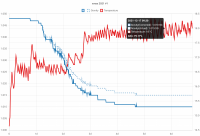I read a few other posts and this is a mash up that might improve on a straight smash:
- 5% or so invert to dry it out
- 10% torrified wheat
- more attenuating yeast than a fullers. Maybe W. Yorkie for some character or Notty for neutral or whatever be your favorite. Pub is one of the least attenuating yeasts out there.
Well, while I've not brewed with Chevallier, I'd certainly support your ambition. I think an addition of invert would be very advantageous and could be of a highly flavored type as from my perspective, Chevallier malt can overpower all else present. 10% torrified wheat is commonly used today in UK breweries, but think that might be difficult if all conversion enzymes come from the Chevallier malt.
Chevallier is a difficult beast to work with; it took six months of research before I was happy using it to make the beer, is an excerpt from page 2. The first 2 paragraphs on that same page relate to a project of which I attended a talk by Keith Thomas, and had a pint made with Chevallier which didn't hit the spot for me. Since that occasion I've had no further direct feed from professionals, but have from amateurs with serious determination, all of whom found one or more difficulties brewing with Chevallier.
It should be understood I'm an old fashioned brewer, more precisely using methods of British family brewers in the twentieth century until, one way or another, most were taken out of business. I brew with natural local water, reducing alkalinity with acids before the 90 minute mash, a fly sparge followed by a 90 minute boil amongst other things. Anything I write may potentially assume such and adaptation to other brewing systems and procedures would therefore warrant consideration.
With that in mind, I wondered if Chevallier has sufficient enzymes to convert both the torrified wheat and itself, or might an addition of an enzyme rich malt or extract help? Maybe an extended mash or not mashing out could help too. Commercial inverts are typically 95% fermentable and maybe homemade varieties, but I don't find sugar to thin a beer, indeed, usually adding character. It does appear to ferment more quickly than fermentables from barley malt, or it appears so when adding sugar to the FV a day into fermentation with almost immediate greater activity. A Yorkshire yeast could allow intervention to avoid a too low gravity beer by skimming and gentle cooling, to slow fermentation as it approached FG, with most more complex sugars remaining. I'm not sure if Nottingham differentiates between those.















































![Craft A Brew - Safale S-04 Dry Yeast - Fermentis - English Ale Dry Yeast - For English and American Ales and Hard Apple Ciders - Ingredients for Home Brewing - Beer Making Supplies - [1 Pack]](https://m.media-amazon.com/images/I/41fVGNh6JfL._SL500_.jpg)














